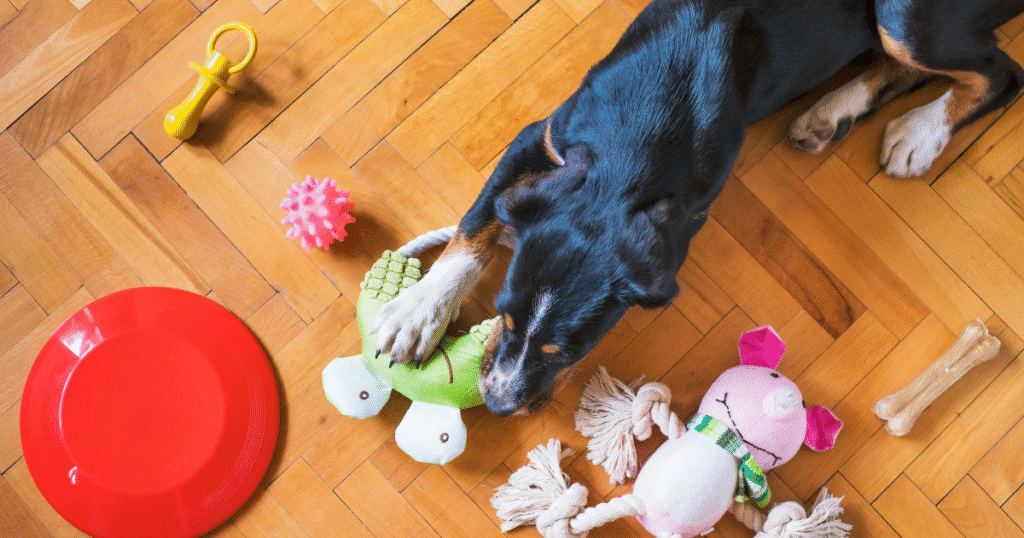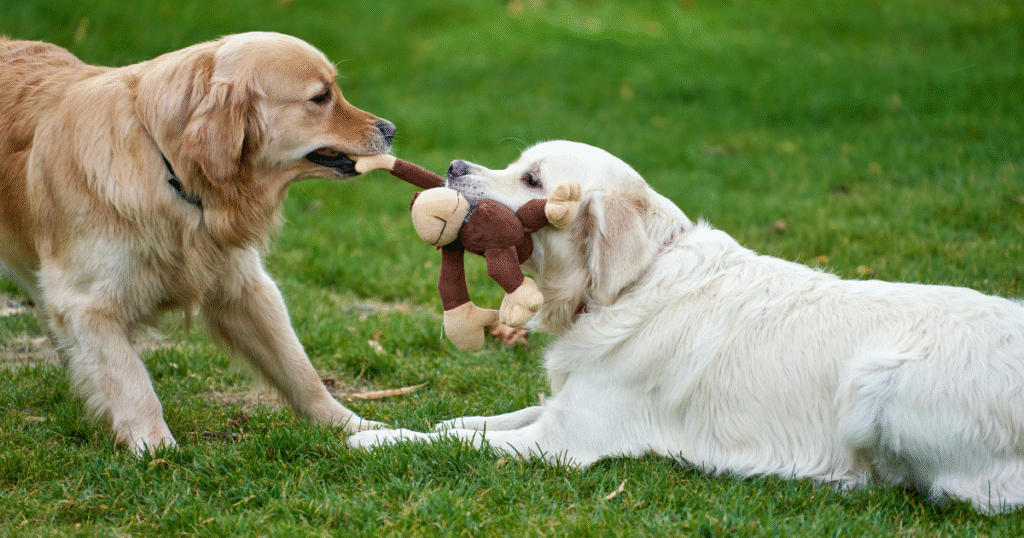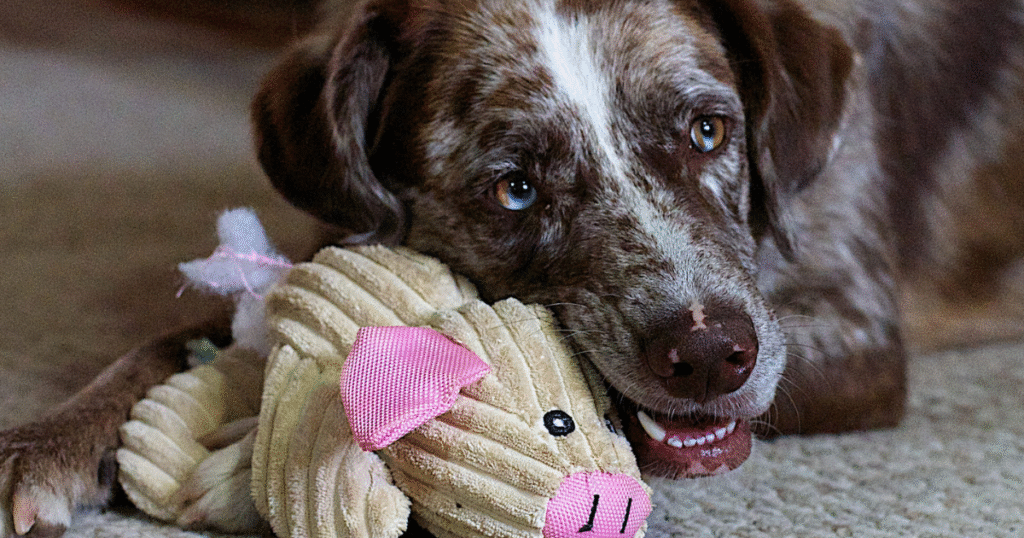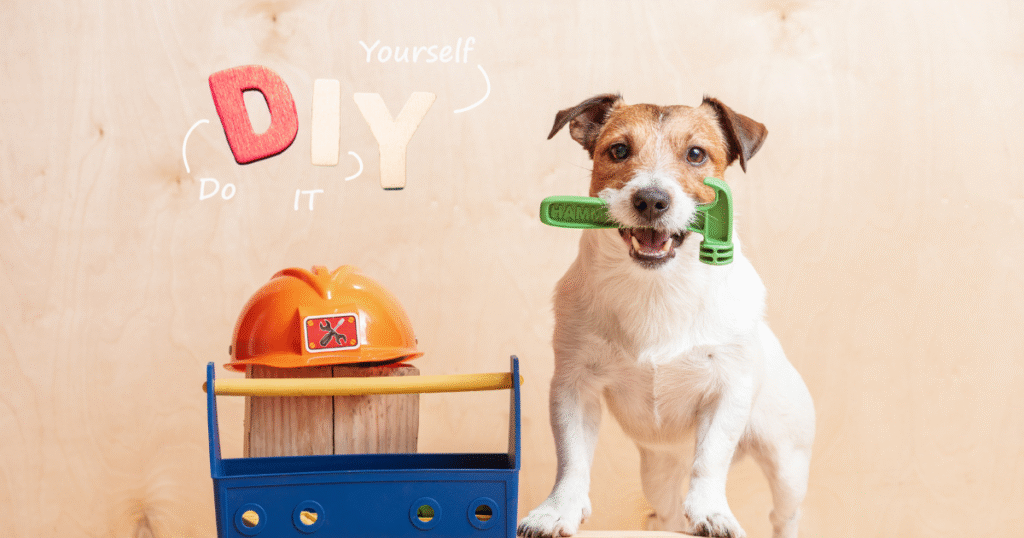As a responsible dog owner, your pup’s health and happiness are always a priority. You probably pay attention to the food they eat, the exercise they get, and the vet checkups they need. But what about the toys they chew on every day? Many conventional dog toys contain harmful chemicals that can pose serious health risks. For eco-conscious pet parents, choosing non-toxic dog toys is more than a trend—it’s a commitment to your pet’s well-being and the environment.
In this guide, we’ll explore what makes a dog toy non-toxic, the materials to avoid, which brands you can trust, and how to keep your dog’s playtime both fun and safe. Whether you’re shopping for a new puppy, a heavy chewer, or looking for eco-friendly options, you’ll find everything you need here.

Table of Contents
Why Choosing Non-Toxic Dog Toys Matters
Dogs interact with their toys using their mouths. They chew, lick, carry, and sometimes even eat pieces of them. That means any harmful substances in those toys can easily enter your dog’s system.
Health Risks from Toxic Toys
- BPA & Phthalates: Often found in cheap plastics, these endocrine disruptors have been linked to hormone imbalance and developmental issues.
- Lead & Heavy Metals: Can cause neurological and behavioral problems.
- Formaldehyde & PVC: May lead to respiratory issues and even cancer with prolonged exposure.
Unfortunately, pet toys aren’t regulated the way children’s toys are. A 2009 study by the Ecology Center found that many pet products, including toys, contained dangerous levels of lead, chromium, and cadmium.
By choosing non-toxic toys, you’re reducing your dog’s risk of exposure to these harmful substances and supporting manufacturers that prioritize safety.
Common Toxic Materials Found in Dog Toys
Not all dog toys are created equal. Some materials may seem safe at first glance but are loaded with hidden toxins.
Materials to Avoid
- PVC (Polyvinyl Chloride): Often contains phthalates and lead.
- Vinyl: A softer form of PVC; releases chemicals when chewed.
- Low-grade rubber and plastics: May contain BPA and other toxins.
- Artificial dyes and glues: Can cause allergic reactions or contain carcinogens.
Red Flags to Watch For
- Strong chemical or artificial smells
- No material information or country of origin listed
- Made in countries with lax safety standards
- Bright, synthetic dyes with no testing certification
Eco-conscious consumers should look for full transparency from manufacturers. If the toy doesn’t clearly state what it’s made of, it’s best to skip it.

What Makes a Dog Toy Non-Toxic?
Non-toxic dog toys are made from safe, durable, and often biodegradable materials that pose no harm to pets or the planet.
Safe Materials to Look For
- Natural Rubber: Durable and safe for most dogs, especially chewers.
- Organic Cotton: Chemical-free and safe to chew.
- Hemp: Naturally antibacterial and eco-friendly.
- Food-Grade Silicone: Used in high-quality puzzle toys.
- Recycled, Tested Plastics: Only if certified as non-toxic.
Certifications That Matter
- OEKO-TEX: Ensures the fabric has been tested for harmful substances.
- GOTS (Global Organic Textile Standard): Guarantees organic production of cotton and other fibers.
- FDA Compliance: Ensures food-grade materials.
- Made in the USA/EU: Higher manufacturing and safety standards.
Label Checklist for Eco-Conscious Buyers
- “Non-toxic”
- “BPA-free”
- “Phthalate-free”
- “Organic” or “natural”
- Country of origin and material transparency
Best Non-Toxic Dog Toys by Type
Depending on your dog’s size, breed, and play style, the right toy will vary. Here’s a breakdown of the safest, most eco-friendly options.
For Puppies (Teething Stage)
- Material: Soft natural rubber, organic cotton
- Why: Gentle on gums, safe to chew
- Top Picks:
- KONG Puppy Toy (BPA-free, natural rubber)
- P.L.A.Y. Plush Toys (made with eco-friendly dyes and recycled fill)
For Aggressive Chewers
- Material: Thick natural rubber or reinforced recycled materials
- Why: Durable and long-lasting
- Top Picks:
- Goughnuts MAXX Stick (engineered for power chewers, non-toxic rubber)
- Planet Dog Orbee-Tuff (recyclable, FDA-approved materials)
For Fetch and Tug
- Material: Organic hemp ropes, natural rubber balls
- Why: Soft but strong, safe for mouth contact
- Top Picks:
- West Paw Jive Ball (made in USA, recyclable, BPA-free)
- Beco Hemp Rope Toy (eco-friendly and compostable)
For Mental Stimulation
- Material: Food-grade silicone or safe plastic composites
- Why: Safe for dispensing treats and encouraging problem-solving
- Top Picks:
- West Paw Qwizl (dishwasher safe, non-toxic)
- Outward Hound Fun Feeder (free from BPA, PVC, and phthalates)
Comparison Table
| Toy Type | Material | Best For | Recommended Brand |
|---|---|---|---|
| Teething Puppy | Organic cotton | Gum relief | KONG, P.L.A.Y. |
| Heavy Chewer | Natural rubber | Durability | Goughnuts, Planet Dog |
| Tug & Fetch | Hemp, rubber | Interactive play | Beco, West Paw |
| Puzzle/Interactive | Silicone, safe plastic | Mental stimulation | West Paw, Outward Hound |

How to Test and Maintain Non-Toxic Toys
Even the safest toys require care. Regular maintenance ensures they stay clean and functional.
Cleaning Tips
- Natural rubber and silicone toys: Dishwasher-safe (top rack)
- Fabric toys: Machine wash on a gentle cycle
- Rope toys: Soak in white vinegar and hot water for 30 minutes
Inspect for Wear
- Fraying, cracking, or broken seams
- Missing chunks (especially for aggressive chewers)
- Discoloration or mold
When to Replace
- Every 1–3 months for heavy use
- Immediately if damage is visible
DIY Non-Toxic Dog Toy Ideas

Making your own dog toys can be fun, cheap, and eco-friendly. Just be sure the materials are safe.
- Braided T-Shirt Rope: Use 100% cotton shirts (no screen prints)
- Frozen Carrot Chew: Peel, freeze, and supervise play
- Muffin Tin Puzzle: Hide treats under tennis balls (only if they’re non-toxic)
- Hemp Rope Tug: Tie knots in organic hemp rope for a durable tug toy
- Sock-and-Bottle Crunch Toy: Only if the bottle is BPA-free and cap is removed
Tip: Avoid toys made with synthetic fabrics, glued-on decorations, or parts small enough to swallow.
FAQs About Non-Toxic Dog Toys
Are “natural” toys always safe?
Not necessarily. Always check for certifications and material sources. Some toys labeled “natural” still use synthetic dyes or unsafe fillers.
How do I know if a toy is truly non-toxic?
Look for labels like BPA-free, phthalate-free, and certifications like OEKO-TEX. Transparency from the manufacturer is key.
Are non-toxic toys available for small breeds?
Yes! Brands like West Paw and P.L.A.Y. offer size-specific toys suitable for small dogs.
How can I sanitize my dog’s toys safely?
Use hot water and mild, pet-safe detergent. For fabric and rope, white vinegar is a natural disinfectant.
Final Thoughts: Top Brands to Try
Your dog deserves the best—and that includes toys that are safe, durable, and eco-friendly. Choosing non-toxic toys is a simple but powerful step toward better pet health and a cleaner planet.
- West Paw: Made in Montana, recyclable, certified safe
- P.L.A.Y. (Pet Lifestyle and You): Sustainable, organic fill, creative designs
- Goughnuts: Engineered for extreme chewers, lifetime guarantee
- Planet Dog: Recyclable and FDA-compliant materials
- SodaPup: Made in USA, safe for power chewers, eco-conscious focus

